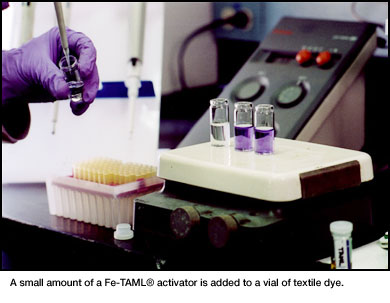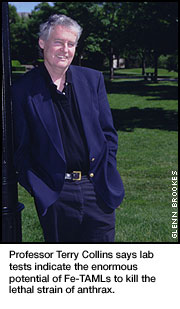|
|
||||
|
|
 Terry Collins Develops "Green" Catalysts for Potential Use in Industry and Biological Warfare � Fe-TAML activators could be used to decontaminate anthrax Terry Collins, the Thomas Lord Professor of Chemistry at Carnegie Mellon University, has developed environmentally safe oxidation catalysts that can be used to decontaminate biological weapons, such as anthrax, and eliminate toxic residues produced by several industries. Members of Collins' laboratory presented the latest findings on this work at the recent American Chemical Society (ACS) meeting in New York City. The oxidation catalysts, called Fe-TAMLŽ (TAML stands for tetra-amido macrocyclic ligand) activators, are made from elements found in nature and work in combination with hydrogen peroxide to convert harmful pollutants into less toxic or harmless substances. Fe-TAML research is the keystone of Collins' work.
Fe-TAMLs—groundbreaking from both an environmental and a scientific perspective—could potentially be used to replace chlorine-based oxidants in large global technologies so toxic industrial residues are not produced. The activators also show great promise to address problems such as general water purification. At the ACS meeting, Collins and his research group discussed Fe-TAMLs' effectiveness in killing an anthrax simulant (a benign form of the deadly biological warfare agent), reducing fuel pollutants, detoxifying pesticides, treating pulp and paper processing byproducts, cleaning wastewater from textile dye manufacturing and catalyzing chemical reactions with oxygen instead of hydrogen peroxide. Tests show that a Fe-TAML activator used with hydrogen peroxide can substantially decontaminate a cultured, benign simulant of anthrax. This anthrax simulant is commonly used in the laboratory testing of agents designed to eliminate its more deadly cousin, which is considered a significant biological warfare and terrorist threat. "In our laboratory tests, Fe-TAMLs are highly promising in cleaning up an anthrax simulant, Bacillus atrophaeus," Collins said. "These results indicate the enormous potential of Fe-TAMLs to kill the lethal strain of anthrax and to eradicate other water-borne infectious microbes that account for significant death and disability worldwide." Collins said Fe-TAMLs can also remove more than 85 percent of recalcitrant sulfur compounds in refined automotive fuels. With further development this technology may provide an attractive alternative to existing methods that rid fuels of sulfur contaminants associated with serious human health problems and contribute to acid rain. These same contaminants also cause engines to burn fuel less efficiently. Collins' research team also has found that Fe-TAML activators and hydrogen peroxide appear to totally break down some organophosphorus compounds, a widely used class of agricultural pesticides. Although effective at curbing insect damage to crops, some organophosphorus compounds have been associated with neurotoxicity and other health problems. Toxic compounds and colored pollutants resulting from paper and wood pulp processing can be destroyed using Fe-TAML activators. "Right now, we can use Fe-TAMLs with hydrogen peroxide to clean up the unsightly color from chlorine-based bleaching processes used by mills to make paper and the chlorinated byproducts of those processes, which are considered a potential health hazard," said Collins, who describes the results of the decolorization as going from 'coffee' to 'lemonade.' Textile mills also may be able to use Fe-TAMLs to significantly decolorize dyes found in their wastewater. By using Fe-TAMLs, textile mills could increase the amount of dye removed from mill effluent, according to Colin Horwitz, a research associate professor at Carnegie Mellon, who added that employing Fe-TAML activators could enable manufacturers to recycle water used in textile dyeing. This step would reduce overall plant costs and save millions of gallons of water yearly over the entire industry. The Collins' group has shown that Fe-TAMLs can work with oxygen in addition to hydrogen peroxide, thereby extending the range of applications made possible through the use of Fe-TAML. These latest findings have the potential to extend the use of Fe-TAML activators to remediate environmental problems and to modify industrial processes to make them more efficient and productive. Collins' research team consists of four senior researchers, one postdoctoral appointee, six graduate students and three undergraduates. The team has been awarded numerous U.S. and foreign patents covering the composition of Fe-TAML catalysts and their methods of use in a wide number of applications. The number of patents continues to grow as work on Fe-TAML activators progresses. To learn more about Fe-TAML activators and the Institute for Green Oxidation Chemistry, visit www.chem.cmu.edu/groups/collins/ and www.cmu.edu/mcs/. �
David Platt
|
||
|
Carnegie Mellon Home |
||||
 Collins heads Carnegie Mellon's Institute for Green Oxidation Chemistry (IGOC) in the Mellon College of Science. IGOC pursues research, education and development of holistic approaches in green chemistry. The institute emphasizes replacing polluting technologies with benign, green alternatives.
Collins heads Carnegie Mellon's Institute for Green Oxidation Chemistry (IGOC) in the Mellon College of Science. IGOC pursues research, education and development of holistic approaches in green chemistry. The institute emphasizes replacing polluting technologies with benign, green alternatives.